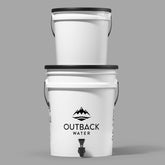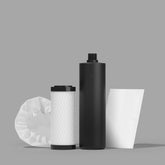Gravity-Powered Filtration and Purification at Work
Gravity-Powered TM Filtration Technology
OutbackWater.com offers Gravity-PoweredTM products that remove or deactivate contaminants without the use of chemicals. These filtration devices are often the filtration method of choice because they are not only extremely effective but they are simple to use. What follows is a discussion of the filtration technologies utilized in this process and the reasons for their use.
General Filtration
Unlike what you may be led to believe, not all filters are created equal. In reality there are a wide variety of types of water filters, designed to remove a wide range of contaminates - from the removal of simple debris, to the removal of pathogenic waterborne micro-organisms. To meet these varying challenges there is an equally wide variety of filter "medium" (filtration material) incorporated in these filters to do the job required. Generally, water filters are designed to treat water that is under pressure. The pressure can range from 20 – 200 psi (pounds per square inch) depending upon how it is being generated. Typically these filters are installed on systems (in homes, offices, manufacturing facilities, etc.) fed by municipal water supplies or in applications where a pressure pump can be added to create the amount of pressure required to effectively accomplish the filtration process.
Non Pressure Driven Filtration = Gravity Power
What happens when we find ourselves in situations where we do not have a pressurized water supply .... situations where we must rely on only "head pressure" or "hydrostatic head pressure", pressure which, for example, may only be what is created by a bucket of water? Can we still effectively remove unwanted contaminants from the water? The answer is, Yes. To successfully remove contaminants in these conditions we utilize gravity - what we refer to as Gravity-PoweredTM Technology. This drawing is a cut-away of a Gravity System illustrating the purification or filtration process as water flows through the various filters and/or purification devices in one of the OutbackWater systems. (click to enlarge)
What is Gravity-PoweredTM Filtration and how does it work?
To understand Gravity Powered Filtration one must first understand the differences between "standard filters" or filters designed for use in pressure driven applications, and "gravity filters" or filters designed for use non-pressurized applications. This discussion involves several elements including the filtration media or material, flow resistance, material removal capabilities, and the structural integrity of the design. Does the chosen material encourage or restrict the flow of water? Can the desired flow rate can be achieved and, if so, are those materials capable of removing the desired contaminants in the given design configuration.
To better understand each of these key components let us take a closer look . First, some material or filter media utilized in water filters exhibit hydrophobic characteristics. In short, these media naturally repel water. Water beads on their surface and does not pass through the surface easily. Filters made using hydrophobic materials restricts the water flow. Although appropriate in pressurized systems, hydrophobic materials are not suitable for use in non/low pressure driven or Gravity-PoweredTM systems. Conversely, materials with an affinity (natural liking) for water (those where the water spreads across the surface creating maximum contact) are known as having hydrophilic characteristics. Hydrophilic materials have the characteristics of absorbing water and water passes more easily through the surface of these filters, creating minimal flow resistance - making them ideal for use in low/non pressurized or Gravity-PoweredTM systems.
The next critical factor - as important as the filter media’s flow resistance - is that media's ability to remove the desired contaminant. This is often based on the size of the pours or openings. For instance, if a flat sheet material is to be used in a gravity application, a hydrophilic, flexible, non-metallic media is recommended. Most often composed of cloth or non-woven fibers such as glass or cotton, these fibrous materials are woven into a web-like configuration with uniform pour sizes (micron rating) to achieve the removal of specific, size-related contaminants, such as sediment, bacteria and cysts. In some cases they are capable of ultra-filtration - defined as filtration using a medium fine enough to retain colloidal particles, viruses, or large molecules. (In some cases additional materials such as carbon can be adhered to the fibrous material to help in the removal of additional contaminants.) The flat sheet material is most often pleated to maximize the filters surface area and help minimize back pressure.
At this point we have selected an appropriately hydrophilic flat sheet filtration media, which has removal capabilities suitable for the application. We now pleat that material - creating what the industry calls a "pleat pack" from the flat sheet material - maximizing the number of pleats to maximize filtration surface area for maximum filter efficiency. And there is still more!
The final two critical factors are structure and fit. First, we ensure structural soundness of the filter by creating a solid "skeleton" or "frame" designed to support and protect the pleated filter media. A solid center core is the 'spine' and an outer shroud (like the rib cage) protects the heart of the filter - the media pleat-pack. All are solidly connected to durable end caps to complete the body of the filter.
Finally the filter is 'fitted' to the system in a secure, leak-proof, and by-pass proof manner by using either a threaded connection or a double o-ring seal.
Loose-packed filters (canisters) or filters incorporating hollow fiber membrane material (Hollow Fiber Technology - How It Works) can also be used in Gravity-PoweredTM filtration applications. In this case canisters are loosely filled with the media (compaction will hinder the flow in a gravity environment) and either wire mesh, screens, or highly porous pads are placed inside both ends of the canister to contain the media and avoid migration into the water. These screens have openings small enough to contain the loaded media yet large enough to minimize any flow restriction. They are held in place by installing end caps on both ends of the canister. Loose-pack filters can contain a variety of media based on the contaminant removal required. Commonly used media with excellent general removal capabilities are granular activated carbon or anion resin but the filter might also contain material designed to remove specific contaminants - Arsenic, for example. As with the 'pleat-pack' filter, the integrity of the design and fit are still of paramount importance.
Advantages of Gravity-Powered Technology
There are several advantages to using a gravity system. It can be used virtually any place a water supply is available. It is extremely portable. It requires no installation. And finally, with proper filter selection, its effectiveness in removing 'undesirables' from the water is unmatched by any other portable system. The key to this enhanced filtration is the “contact time” - the amount of time the water is allowed to remain in contact with the filter media. The slower flow rate of the Gravity-Powered system greatly multiplies this “contact time” generating enhanced opportunities for the media to do its job, resulting in high levels of contaminate removal. Look at the test results for these products!
NOTES:
*Filter Medium or Media (by definition): is a natural or synthetic material or a manufactured article used for filtration. Filter media have a porous structure, that is, a structure permeable to liquids and gases. The filter media should have the following properties.
1. An appropriate porosity (that is, the pores should be of such a size that the particles of the filter cake are trapped in the filter medium).
2. Chemical resistance to the filtrate.
3. Sufficient mechanical strength.
4. Thermal resistance at the temperature at which the filtration is carried out.
Filter media may be either flexible or inflexible. Flexible filter media include metallic barriers in the form of perforated sheets or screens made of steel, cooper, aluminum, nickel, silver or other materials. Such media are especially suitable for the filtration of chemically aggressive fluids and for the filtration at elevated temperatures or large mechanical stresses. Flexible media also may be nonmetallic barriers consisting of cloth or unwoven fibers. Such nonmetallic media may be made of asbestos, glass, cotton, wool, polyvinyl chloride or poly fiber. Inflexible media include rigid disks, slabs, canisters and sheets made by molding sintering (make (a powdered material) coalesce into a solid or porous mass by heating it (and usually also compressing it) without liquefaction) powdered ceramics, metals, glass or synthetic materials. Such media also may consist of beds of unconsolidated particles of stone, coal, charcoal, coke, diatomaceous earth, sand or clay.
There is often a distinction made between thin filter media and thick, or en masse, media. In thin media, such as filter paper or filter cloth, the pores are smaller than the particles to be removed from the fluid. The pores of thick media, such as a charcoal bed or wood pulp, may be appreciably larger than the particles to be removed.
- Choosing a selection results in a full page refresh.





